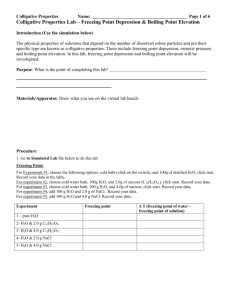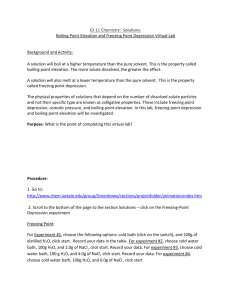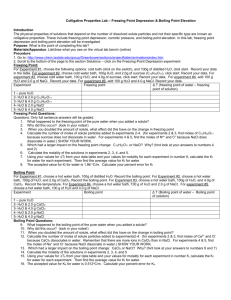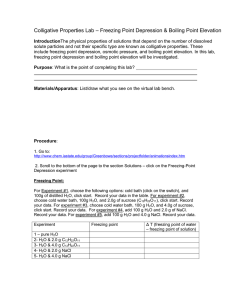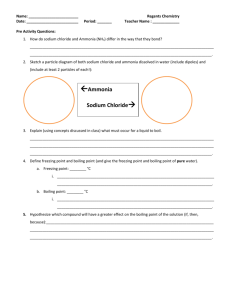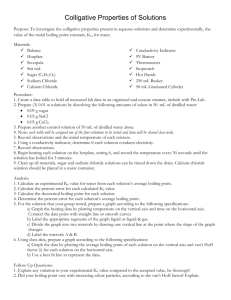Colligative Properties Lab: Freezing & Boiling Point
advertisement
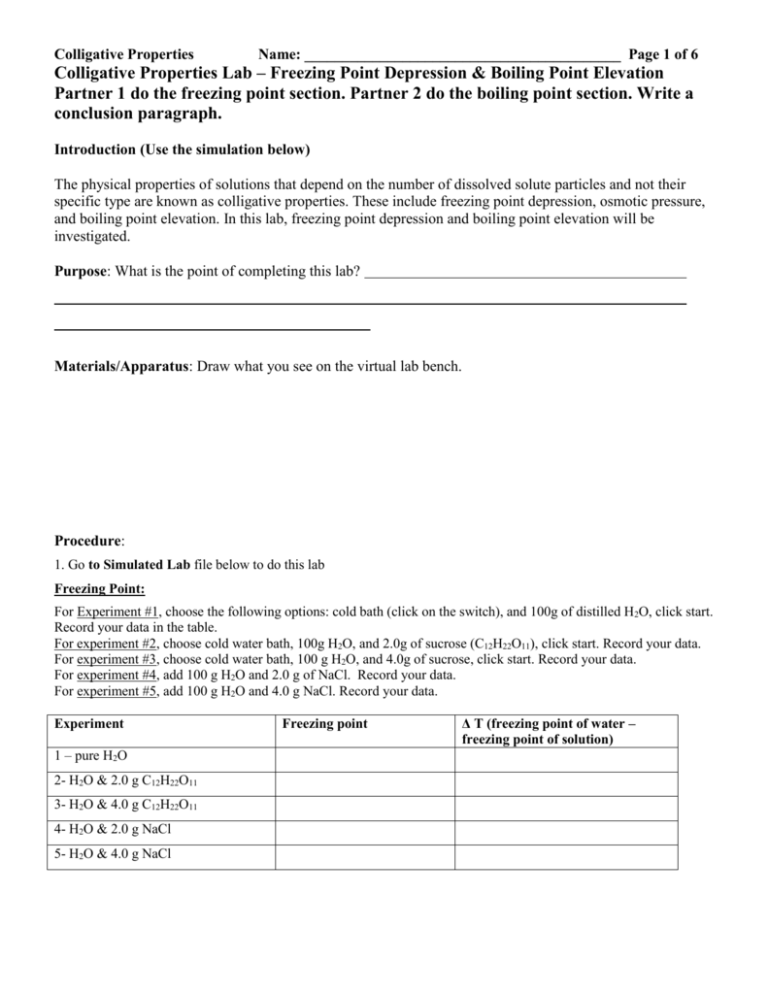
Colligative Properties Name: __________________________________________ Page 1 of 6 Colligative Properties Lab – Freezing Point Depression & Boiling Point Elevation Partner 1 do the freezing point section. Partner 2 do the boiling point section. Write a conclusion paragraph. Introduction (Use the simulation below) The physical properties of solutions that depend on the number of dissolved solute particles and not their specific type are known as colligative properties. These include freezing point depression, osmotic pressure, and boiling point elevation. In this lab, freezing point depression and boiling point elevation will be investigated. Purpose: What is the point of completing this lab? Materials/Apparatus: Draw what you see on the virtual lab bench. Procedure: 1. Go to Simulated Lab file below to do this lab Freezing Point: For Experiment #1, choose the following options: cold bath (click on the switch), and 100g of distilled H2O, click start. Record your data in the table. For experiment #2, choose cold water bath, 100g H2O, and 2.0g of sucrose (C12H22O11), click start. Record your data. For experiment #3, choose cold water bath, 100 g H2O, and 4.0g of sucrose, click start. Record your data. For experiment #4, add 100 g H2O and 2.0 g of NaCl. Record your data. For experiment #5, add 100 g H2O and 4.0 g NaCl. Record your data. Experiment 1 – pure H2O 2- H2O & 2.0 g C12H22O11 3- H2O & 4.0 g C12H22O11 4- H2O & 2.0 g NaCl 5- H2O & 4.0 g NaCl Freezing point Δ T (freezing point of water – freezing point of solution) Colligative Properties Freezing Point Questions: Name: __________________________________________ Page 2 of 6 Questions: Only full sentence answers will be graded. 1. What happened to the freezing point of the pure water when you added a solute? 2. Why did this occur? 3. When you doubled the amount of solute, what effect did this have on the change in freezing point? 4. Calculate the number of moles of solute particles added to experiments 2-4. (for experiments 2 & 3, find moles of C12H22O11 because sucrose does not dissociate in water. For experiments 4 & 5, find the moles of Na+ and Cl- because NaCl does dissociate in water.) SHOW YOUR WORK. Experiment 2 Experiment 3 Experiment 4 Experiment 5 5. Which had a larger impact on the freezing point change: C12H22O11 or NaCl? Why? (hint look at your answers to numbers 4 and 2) 6. Calculate the molality of the solutions in experiments 2, 3, 4, and 5 Experiment 2 Experiment 3 Experiment 4 Experiment 5 Colligative Properties Name: __________________________________________ Page 3 of 6 Using your values for ∆Tf from your data table and your values for molality for each experiment in number 6, calculate the Kf for water for each experiment. Then find the average value for Kf for water. Experiment 2 Experiment 3 Experiment 4 Experiment 5 Average The accepted value for Kf for water is 1.86 oC/m. Calculate your percent error for Kf. Boiling Point: For Experiment #1, choose a hot water bath, 100g of distilled H2O. Record the boiling point. For Experiment #2, choose a hot water bath, 100g of H2O, and 2.0g of CaCl2. Record the boiling point. For Experiment #3, choose a hot water bath, 100g of H2O, and 4.0g of CaCl2. Record the temperature. For Experiment #4, choose a hot water bath, 100 g of H2O and 2.0 g of NaCl. For experiment #5, choose a hot water bath, 100 g of H2O and 4.0 g of NaCl. Experiment 1 – pure H2O 2- H2O & 2.0 g CaCl2 3- H2O & 4.0 g CaCl2 4- H2O & 2.0 g NaCl 5- H2O & 4.0 g NaCl Boiling point Δ T (Boiling point of water – Boiling point of solution) Colligative Properties Name: __________________________________________ Page 4 of 6 Boiling Point Questions: 7. What happened to the boiling point of the pure water when you added a solute? 8. Why did this occur? (look in your notes!) 9. When you doubled the amount of solute, what effect did this have on the change in boiling point? 10. Calculate the number of moles of solute particles added to experiments2-4. (for experiments 2 & 3, find moles of Ca2+ and Cl- because CaCl2 dissociates in water. Remember that there are more ions in CaCl2 than in NaCl. For experiments 4 & 5, find the moles of Na+ and Cl- because NaCl dissociate in water.) SHOW YOUR WORK. Experiment 2 Experiment 3 Experiment 4 Experiment 5 10. Which had a larger impact on the boiling point change: CaCl2 or NaCl? Why? (hint look at your answers to numbers 9 and 7) 11. Calculate the molality of the solutions in experiments 2, 3, 4, and 5 Experiment 2 Colligative Properties Name: __________________________________________ Page 5 of 6 Experiment 3 Experiment 4 Experiment 5 Using your values for ∆Tb from your data table and your values for molality for each experiment in number 6, calculate the Kf for water for each experiment. Then find the average value for Kf for water. Experiment 2 Experiment 3 Experiment 4 Experiment 5 Average 12. The accepted value for Kb for water is 0.512oC/m. Calculate your percent error for Kb. Conclusion Questions 1. Why is a molality concentration scale used in the context of colligative properties and not the more common concentration scale, molarity? 2. Assume that you have a solution of an unknown solute in cyclohexane. If the solution has a freezing point depression of 9.50 0C, what is the molality of this solution? (The freezing point depression constant for cyclohexane (Kf) is 20.4 0C/m). Colligative Properties Name: __________________________________________ Page 6 of 6 3. Cyclohexanol, C6H11OH, is sometimes used as the solvent in molecular weight determination by freezing point depression. If 0.253 g of benzoic acid, C6H5COOH, dissolved in 12.45 g of cyclohexanol, lowered the freezing point of pure cyclohexanol by 6.55 0C, what is the molal freezing point constant (Kf) of this solvent? 4. What is supercooling? How can it be minimized? 5. Distinguish between non-volatile and volatile substances. Give two examples of each. 6. Write a conclusion paragraph about how this lab re-enforces the concepts of colligative properties and any improvements/problems with the lab.
